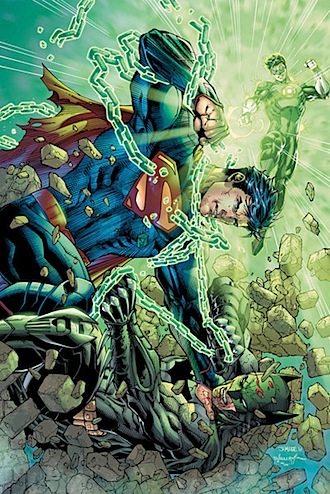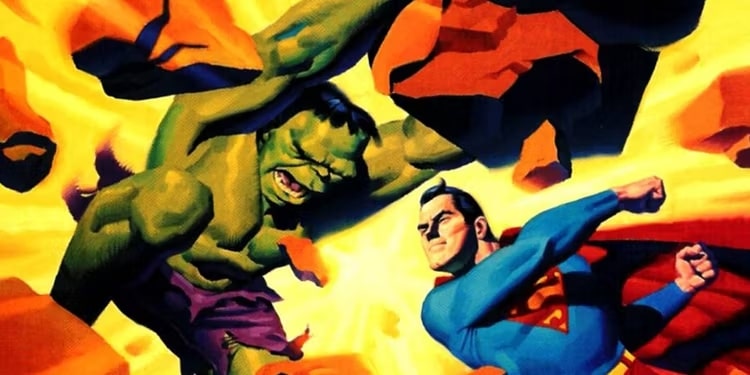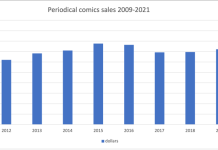
• Highest dollar sales for the Top 300 comics. Retailers ordered comics in the Top 300 worth $25.36 million in October, the highest total for that figure since the Diamond Exclusive Era began in the mid-1990s. The previous record was held by October 2008, with $24.9 million in orders. The totals in the early 1990s were likely higher, even given inflation.
• Most titles in the Top 300 by a publisher. DC placed more titles in the Top 300 than any publisher since the Diamond Exclusive Era began in 1996: 129. All but one of the “New 52” titles that launched in the previous month reappeared in the Top 300. The previous high-water mark was set by Marvel, which had 119 entries on the charts in December 2008 and June 2009. I do not have exact counts from the charts from before 1996, and reorders would not have been included on any charts before 2003. DC’s previous high-water mark was 107 entries in October 2007.
• Largest number of issues reappearing in the Top 300. I haven’t really kept this statistic before, but there always a few titles from the previous month that reappear on the list. As mentioned, this month dwarfed any previous experiences, as 51 out of the 52 DC reboot titles that appeared on the charts in September 2011 reappeared. (The only which didn’t make the Top 300 again is Men of War, but that is not necessarily because of a lack of demand — if most of its print run was reported by Diamond as sold in September, it might not have charted again.)
Miller has tons more analysis in the link, but it’s obvious that the new 52 not only swelled DC’s coffers but did bring in new and lapsed readers to lift the entire industry. Who knew such a thing was even possible?








“ICv2’s will be out tomorrow”
Already available: http://www.icv2.com/articles/news/21453.html
Yeah, we’re all working fast today!
I have also finally updated the 1997-onward item count graph and raw data table to include the last three years, which helps illustrate the scale of what happened this month:
http://www.comichron.com/vitalstatistics/itemcount.html
Let’s hope Paul and Marc-Oliver can also work fast…we still don’t have September’s month-to-month charts yet!
When did retailers order books for October? I don’t think anyone had read any of the new #1’s when retailers ordered books for October.
Marvel’s Final Order Cut-off (FOC) for October was:
09/12/2011 (Monday) for books going on-sale 10/05/2011 (Wednesday). Three and a half weeks.
So, if DC has a similar schedule, then the New 52 was out for two weeks when the first October orders were due, for the second issues of those titles which were selling out on the stands. That is, retailers had two weeks of sales data to analyze when ordering issues of the second issues of those titles.
Also, DC initially offered limited returnability on the New 52 titles to encourage retailers to order sufficient quantities for expected customer demand. They have since expanded this through April of 2012.
There was also the preview issue and the huge media push via the DC blog and various websites, which would encourage customers to pre-order or subscribe for subsequent issues.
Rick, not when the original orders were placed, but I think this is where the Final Order Cut-off paid off really freaking well for DC.
If it lasts, man. If it lasts. Lots of comics projects start off super strong and then trickle. I have been cataloging my comics lately, logging them in ComicBase, and it’s been a tour of titles that briefly spawned great excitement – even multiple printings of first and second issues – only to trickle and fade away.
The online discounter I order comics from wanted orders for October to be in no later than August 31. That meant I had to order the #2’s before even reading the #1’s.
Two-months-before is how it always used to be, and how it remains for consumers ordering from Diamond’s print catalog. But retailers could still place Advance Reorders after that deadline, and then the Final Order Cutoff in the 2000s pushed the date as far ahead as it could go and still allow publishers to change their print runs. The bulk of comics are still ordered on that two-month cycle, but technology has allowed orders to be honored closer to the ship dates.
We see the reflection of that in the sales charts. Go back on Comichron and follow some hit series — particularly surprise hits — and you’ll see in the 1990s, it’s the third or sometimes the fourth issue where there’s a real sales bump. But by the time you reach Civil War, #2 has higher orders than #1. Retailers had a better sense of demand, thanks to the FOC for #2 being closer to when #1 came out.